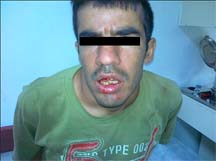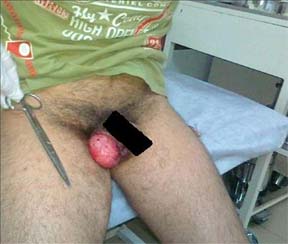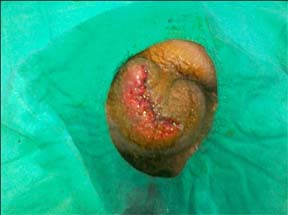Self Mutilation of Genitalia-Using Teeth
Ugur LoK1, Umut Gulacti2, Can Benlioglu3, Hasan Buyukaslan4, Nurettin Aktas5
1Faculty, Department of Emergency,Adiyaman University Medical Facility, Turkey.
2Faculty, Department of Emergency,Adiyaman University Medical Facility, Turkey.
3Faculty, Department of Urology,Adiyaman University Medical Facility, Turkey.
4Faculty, Department of Emergency,Harran University Medical Facility, Turkey.
5Faculty, Department of Emergency,Adiyaman University Medical Facility, Turkey.
NAME, ADDRESS, E-MAIL ID OF THE CORRESPONDING AUTHOR: Dr. Ugur LoK, Faculty, Department of Emergency, Adiyaman University Medical Facility, Turkey.
Phone: 0532 175 95 94,
E-mail:ugurlok@hotmail.com
Genital self-mutilation (GSM) is an uncommon self-inflicted injury, and rarely do self-mutilations have a serious nature. GSM is not a single clinical entity, and it can occur in any psychiatric state or condition. The instruments that are used for self-mutilation can vary, and treatment of these injuries requires a detailed clinical evaluation and multi disciplinary approach. We report here a case report about a 22-year-old mentally retarded man who referred to our emergency service for bloody vomitting by his family members. To our knowledge this is the first such case reported in literature as of injury technique.
Introduction
Self-mutilation is described as the deliberate destruction or alteration of body tissue without conscious suicidal intent. Behaviors that involve damaging bodily tissues without intending suicide are defined as self-mutilation. The most common types of self-mutilation are damaging the skin, eyes and genitals [1,2]. GSM is a rare severe form of self-injurious behavior that is usually described in conjunction with psychotic disorders with delusions and hallucinations. Risk factors for GSM include commanding hallucinations, religious delusions, substance abuse, and social isolation[2-4]. Self-inflicted injuries range from simple lacerations of the external genitalia to complete amputation of the penis and testes. In most cases, penile mutilation is common [4,5]. In a group of 52 cases of GSM, Greilsheimer and Groves found 87% of the patients to be psychotic and 13% of the patients to be non-psychotic. Some authors have further identified three groups of at-risk men: psychotics, character-disordered individuals including transsexuals, and individuals under socio-cultural influences [6]. The major psychotic illnesses in these patients included delusions in chronic paranoid schizophrenia and commanding hallucinations [2,6]. The non-psychotic cases included character disorders, transvestism, and complex religious or cultural beliefs. There have been sporadic cases of non-psychotic GSM in the literature [1,4]. Various forms of psychopathology have been postulated in such cases.
We present here a different form of self-infliction in a patient who was referred to our emergency room as a potential case of upper gastrointestinal bleeding but who had injured himself using his own teeth rather than any instrument.
Case Report
A 22-year-old man was brought to the emergency department by his mother and brother with a history of retching and bloody vomiting that had begun approximately one hour prior. His mother said that he had vomited approximately one glass of blood mixed with pieces of food. The patient was admitted to the emergency critical care unit as a possible case of upper gastrointestinal tract (UGT) bleeding. On physical examination, the clothing covering the patient’s pelvis and gluteal region appeared wet and bloody, his facial expressions and posture suggested mental retardation, and his speech was disordered and not fluent. His vital signs were stable. His apparent injuries included upper gingival hemorrhage, upper incisor instability, and a lower lip mucosal laceration with edema [Table/Fig-1]. Rectal examination demonstrated normal stool configuration. A genitourinary system examination revealed a recent horseshoe-shaped circumferential contracted scrotal laceration on the right side of the scrotum. The laceration extended through different levels to the Buck’s fascia of the scrotum. The configuration of both testes was within normal limits [Table/Fig-2]. The results of blood and coagulation tests were all normal. After excluding a UGT hemorrhage, the patient’s diagnosis was established as a GSM.
Urology and psychiatry consults were called, and the scrotal wound was sutured by a urological surgeon [Table/Fig-3]. The patient was admitted to the urology inpatient clinic. The patient had no complications and was discharged as an outpatient 3 days after admission.
During the evaluation, he said that he had performed the scrotal laceration himself using his teeth. Prior to or during the selfmutilation he experienced no sexual arousal, urge to masturbate or aggression. Furthermore, he said that he did not know why he had performed this action on himself. The patient’s history revealed that he was not married and lived with mother at the same house, but he lived alone in a different room of the home. He had no history of other illnesses and was using no medications, but he complained of frequent epigastric pain. He had been referred to a psychiatrist by a family member earlier in life, but he had not continued the consultations or medications. His mother said that she had heard some sounds at the time of self-infliction, but she was unsure what they might have indicated; in addition, she had assumed that the sounds had come from the barn beneath the home. She went to her son’s room because she heard groaning sounds, and she found her son lying down, vomiting blood and retching.
Plastering-style upper gingival hemorrhage, upper incisor instability, and lower lip mucosal laceration with edema

Recent horse shoe-shaped, circumferential contracted scrotal laceration on the right side of the scrotum. The laceration extended through different levels to the Buck’s fascia of the scrotum

The patient’s sutured scrotal wound

Discussion
GSM is a rare phenomenon. The most common self-mutilating behavior is cutting one’s own wrist, which is usually committed by adolescents or by the mentally retarded for attention-seeking purposes, to resolve tension, or as an epidemic behavior. Rarely, self-mutilation has a serious nature that leads the patient to attempt to amputate his penis, castrate himself, extract his eye or amputate his hand [1]. The vast majority of reported cases have occurred among single, white males in their 20s and 30s [3,5,7]. Our patient fit into these gender and age groups.
The degree of mutilation, the predisposing factors, and the instruments used in the perpetration of this irrational, extraordinary act vary. The instruments that have been used include kitchen knives, blades, scissors, a chainsaw, and an axe. However, there has been no report in the literature of scrotal self-mutilation using the patient’s teeth. Thus, we were surprised that a man had selected this exceptional and gruesome method for mutilation. This is an extraordinary case of GSM performed using the uncommon method, and the absence of similar reports in the literature may be the result of selective reporting of self-inflicted personal injuries [3,8].
The majority of cases, reported in the literature, have been of patients with psychosis or psychiatric disorders with either functional or organic brain disease. Such cases have been observed in schizophrenia or depression with sexual problems; however, it is sometimes difficult to diagnose these conditions because such a behavior is usually the only presenting symptom of the psychiatric disorder. However, a few cases have been described in nonpsychotic persons and often after a period of planning that resulted either from bizarre autoerotic acts or from attempts at crude sex change operations by the transsexuals [1-6]. It has been suggested that there is no difference in the severity of the self-inflicted injuries between psychotic and non-psychotic patients [8]. Although we did not find any reason for self-mutilation in our patient, except mental retardation, we speculate that it may have been performed to lower internal feelings of aggression.
As the degree of mutilation varies so does the treatment, which can be complex and quite challenging. It is often a multidisciplinary responsibility between the urologist, psychiatrist, psychologist, and primary care physician. The ultimate goal of surgical treatment includes restoration of the anatomy and function as much as possible [5]. A superficial laceration may require no more than simple suturing, which was the case for our patient. Complications resulting from GSM vary according to the severity of the injury inflicted and the extent of surgical repair undertaken.
Conclusion
Whether neurotic or psychotic, GSM is a rare phenomenon, but it is not a single clinical entity and can usually occur in any psychiatric condition. Treatment of these injuries requires a multidisciplinary approach. Because this report is the first presentation in the literature of GSM using the patient’s own teeth, we are publishing this case to suggest that GSM should be considered with patients who are mentally retarded and vomiting blood in emergency room.
[1]. RB Nerli, IR Ravish, SS Amarkhed, Genital self-mutilation in nonpsychotic heterosexual males: Case report of two cases Indian J Psychiatry 2008 50:285-7. [Google Scholar]
[2]. E Ozan, E Deveci, M Oral, E Yazici, I Kirpinar, Male genital self-mutilation as a psychotic solution Isr J Psychiatry Relat Sci. 2010 47(4):297-303. [Google Scholar]
[3]. Kn Rao, G Bharathi, S Chate, Genital self-mutilation in depression: a case report Indian J Psychiatry 2002 44(3):297-300. [Google Scholar]
[4]. Charan Sri Hari, Reddy CM Pavan Kumar, Genital self mutilation in alcohol withdrawal state complicated with delirium Indian J Psychol Med. 2011 33(2):188-90. [Google Scholar]
[5]. AA Ajape, BA Issa, OL Buhari, Genital self-mutilation Ann Afr Med 2010 9(1):31-4.doi: 10.4103/1596-3519.62622. [Google Scholar]
[6]. N Eke, Genital self-mutilation: there is no method in this madness BJU Int. 2000 85(3):295-8. [Google Scholar]
[7]. H Stunell, RE Power, JR Floyd M, Genital self-mutilation Int J Urol. 2006 13(10):1358-60. [Google Scholar]
[8]. CY Sudarshan, KN Rao, SV Santosh, Genital self-mutilation in erectile disorderGenital self-mutilation in erectile disorder Indian J Psychiatry 2006 48:64-65. [Google Scholar]